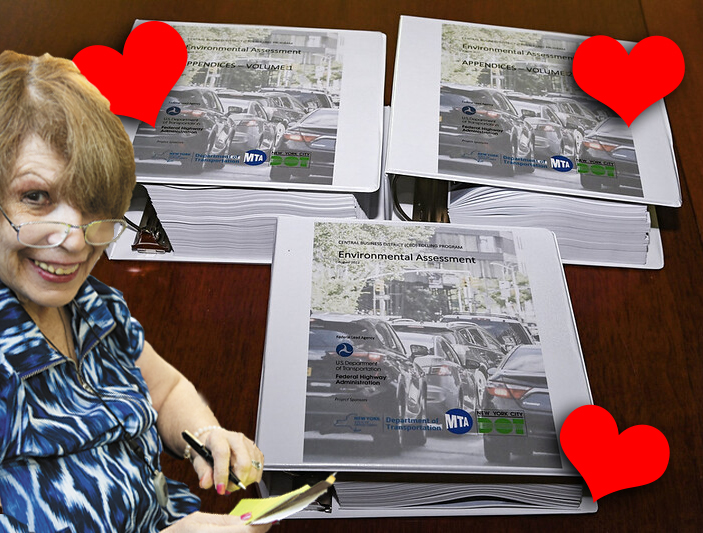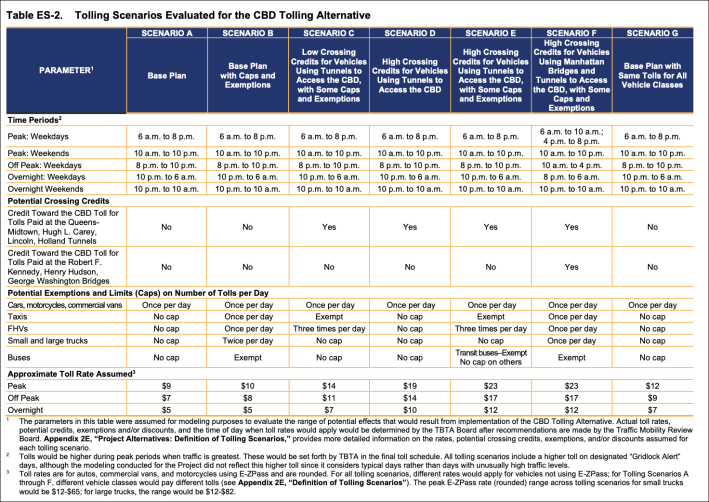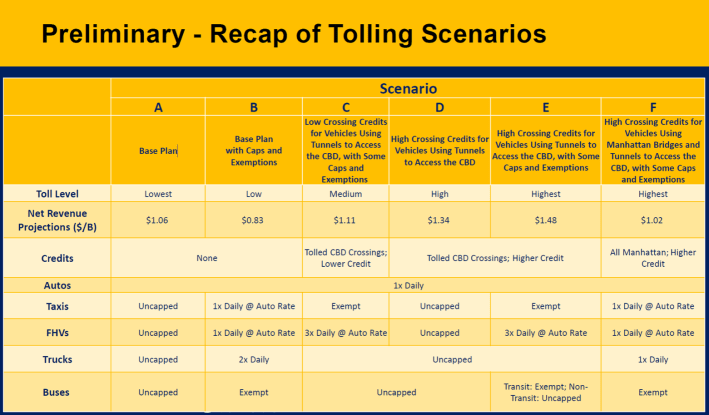Congestion Pricing Matchmaker: Which Tolling Scenario Is Right For You?
6:01 AM EDT on August 10, 2022

Lawyers for the MTA say New Jersey didn’t contribute to this at all, though they could have. Photo: Marc A. Hermann/MTA (with the Streetsblog Photoshop Desk)
After one failed attempt, a successful two-year street fight, two and a half years of federal shenanigans, public comment from residents of 28 area counties and five native American tribes, hundreds of time-sucking questions from Washington bureaucrats, lots of political slow-walking in Albany and enough traffic modeling to crash a supercomputer, the MTA and its congestion pricing partners have finally determined: yes congestion pricing will raise money for transit and reduce traffic in Midtown and, most important, not really have much of an adverse impact on anyone.

That's the key — and, frankly, expected — finding of the MTA's voluminous environmental assessment for what it calls the Central Business District Tolling Program, which was released this morning at 6 a.m. The massive document — roughly three feet high in three nifty binders — compiles every possible effect that the traffic toll can have on things like daily vehicle miles traveled in and around the Manhattan central business district, transit ridership, the lives of low-income drivers and taxi drivers in the CBD and air quality around nearby highways.
It also lays out multiple scenarios for the toll, from a low of $9 in the peak hour to a high of $23 (more on why later), meaning the charge could come in higher or lower than London's current congestion charge of £15 (about $18). But all of the scenarios (well, all but one!) meet the legislature's requirement that the tolls reduce traffic in the Central Business District and raise $1 billion per year (though by how much exactly was left out of the data released to reporters on Tuesday). And all of them charge run-of-the-mill car drivers only once per day, no matter how many trips in and out of the zone.
From there, the scenarios diverge — toll amounts vary, exemptions change, even Jersey residents get appeased in one. But every scenario resulted in fewer auto trips into the CBD and reduced congestion in the region.
The toll ranges themselves are not a final ruling from the MTA. For that, the MTA needs to rely on the Traffic Mobility Review Board, the newly appointed body that makes suggestions on how much people pay and whether anyone gets exemptions. Those suggestions then get passed on to the MTA Board itself, which votes on the actual final prices that people will pay. And the first tolls won't likely be collected until early 2024, five years after it was first made law.
But which congestion pricing scenario is the best? We asked the MTA and it wasn't talking because the fact is, each scenario benefits someone and hurts someone else. So the better question is: which toll scenario is the right one for you? Just as in love, that depends on what kind of person you are.
Two similar charts in the executive summer (chart 1) and in the air quality section (of all places) lay it all out before we break it all down:


Are you interested in the lowest toll for everyone?
A lower toll comes with its own tradeoff: there are basically no exemptions for anyone, not even for MTA buses themselves. But some people will like that scenario because adding even one credit or exemption opens the door to everyone insisting that their life circumstances or chosen profession are so virtuous or pitiable that they also shouldn't have to pay the congestion toll and that just makes the toll higher, leading to more kvetching from everyone not lucky enough to get an exemption.
Enough already, you need an Excedrin just thinking about this noise. Or, you need Scenario A, where everyone gets treated the same and also gets stuck in the same traffic borne by a lower toll.
Under Scenario A, everyone pays: People coming through the tolled tunnels into Manhattan and over the tolled bridges pay. Taxi drivers, for-hire-vehicle drivers, truck drivers and buses all get tolled for each trip they take into the CBD. The simplicity actually means low toll for everyone though, with peak hour tolls of $9, off-peak tolls of $7 and overnight tolls of $5.
But here's a downside: This scenario results in the smallest reduction in daily commuter auto trips into the CBD at 12,571 fewer trips per day.
Are you interested in 'fairness' and really reducing car trips?
Maybe you're big into fairness. Of course, fairness is in the eyes of the beholder, but two scenarios include efforts to be fair to commuters who already pay an existing toll to get into Manhattan, give cab drivers a break by either exempting them or capping their toll payments and limit tolls paid by truck drivers. Known as Scenario E and Scenario F, these are the two most-expensive toll scenarios for drivers, with the same rates: $23/$17/$12.
In Scenario F, drivers coming through the Queens-Midtown Tunnel, the Lincoln Tunnel, the Battery (now Hugh L. Carey) Tunnel, the Holland Tunnel and over the Triborough Bridge, the Henry Hudson Bridge and the George Washington Bridge will get a credit for the cost of those spans or tubes when they enter the CBD. In addition, truck drivers, taxi and FHV drivers only get charged once per day and buses are exempt from the toll. This is also the scenario that uses two peak hour blocks instead of one long block.
Under Scenario E, only drivers coming through the tunnels get toll credits, for-hire-vehicle drivers get tolled up on up to three trips into the CBD per day, truck drivers get charged for every trip they take and taxi drivers and MTA buses are exempt from tolls.
On the one hand, these are scenarios that do nothing to discourage car trips from New Jersey, and they seemingly reward people who are demanding easy car travel into Midtown for expensive Broadway shows. But the tolls in these scenarios is so high that it reduces the total number of auto trips into the CBD by daily commuters by 27,471 total trips per day in Scenario E and 24,433 trips per day in Scenario F, the two largest drops in daily trips out of the scenarios.
Are you interested in environmental justice?
When the MTA started putting together its environmental assessment, it was originally studying six different tolling scenarios. But during the public outreach, the MTA found that people were concerned about truck traffic on the Cross Bronx Expressway, because traffic models showed that some truck drivers who would usually drive through the CBD would divert.
"In particular, trucks would divert to routes on highways in Staten Island and in the South Bronx," the EA states.
In response, the agency created a seventh scenario, Scenario G. In this potential future, every vehicle that crosses into the CBD gets charged the same amount, whether it's a tiny Honda Civic or a huge tractor trailer. As a tradeoff, credits aren't handed out for other tolled crossings, and there's no cap on the number of times a truck driver, taxi driver, FHV driver or bus driver is tolled during the trips into the CBD.
The toll rates of $12/$9/$7 aren't the highest possible charge and they aren't the lowest, but the scenario does the most to keep truck drivers from clogging up the South Bronx by ensuring that truck drivers are charged a low toll.
In the other six scenarios the MTA looked at, 170 to 704 more trucks wind up on the Cross Bronx Expressway per day. In Scenario G, however, only 50 more trucks pass through that section of the highway per day. On the whole, this scenario eliminates 14,578 daily auto trips through the CBD, which is the second-fewest of all the scenarios.
Scenario A, despite leading to an increase of 509 trucks per day on the Cross Bronx, does have an advantage over other scenarios in that it results in the only nine intersections where traffic volumes increase by 50 or more vehicles during peak hour traffic.
Are you interested in seeing Josh Gottheimer cry like a baby?
Should petty vengeance and emotion really determine the way you advocate for transit improvements? Ah what the hell, why not, especially when it comes to a Jersey congressman who, when he isn't whining about congestion pricing, has spent his time trying to decimate anything good the Democrats have been trying to do in Congress.
Anyway, if that's the case, then Scenario C is the one for you. The MTA hands out exemptions and credits like candy in this scenario, but specifically does not credit drivers coming over the upper Manhattan bridges, which is what Gottheimer has been screaming about for months now. People coming in through the Manhattan tunnels get a low credit though, while taxi drivers are totally exempt from the toll and FHV drivers are only tolled a maximum of three trips per day.
There's no cap on the number of times trucks or buses are tolled, which is why the toll prices are slightly higher at $14/$11/$7 per time period, but Scenario C also results in the second-fewest amount of extra daily truck trips on the Cross Bronx Expressway, with 170 per day so it does more than just rub it in for a vocal opponent of the traffic toll. It also takes 17,408 daily trips to the CBD off the road, but there's another way to annoy the New Jersey representative while also reducing traffic, which would be Scenario D.
In Scenario D, the only toll credits given out are for people driving through tunnels into Manhattan, and unlike Scenario C it doesn't cap the number of times truck drivers, taxi drivers, FHV drivers or buses can be tolled. As a result, the toll is lower than the most extreme giveaways in Scenarios E and F, but it's still a higher end toll with $19/$14/$10 breakdown. It also has the third-largest reduction in daily commuter auto trips into the CBD, wth 24,017 fewer trips per day.
Are you interested in seeing this fail?
Uh, good news? The MTA did put together a tolling scenario, the dreaded Scenario B, where the exemptions are given out so freely that congestion pricing doesn't actually raise $1 billion. In this scenario, tolls are $10/$8/$5 and taxis and for-hire-vehicles also get tolled just once per day. Trucks are capped at two tolls per day and buses are exempt from paying the charge.
The low toll does mean that no credits are given for any of the tolled crossings into Manhattan, which means that people coming from New Jersey will be mad anyway. The scenario was included, according to a senior MTA official, in order to respond to public feedback.
"We had a lot of people who expressed concern and wanted to see a low toll but also wanted to see some types of credits and exemptions," the senior official said in an off-the-record briefing for reporters on Tuesday at MTA headquarters. "So we left it in there so people understood what happens if you keep the toll low and you also have credits and exemptions. You end up not being able to meet the financial goals."
In other words, this isn't the right plan for you ... or anyone. State law requires $1 billion, so this one will end up on the scrap heap of history.
But one of the other scenarios will almost certainly be chosen because the only other alternative studied by the MTA is the "no build" scenario, which means not tolls. And no tolls, as MTA Chairman and CEO Janno Lieber said in June, means no accessibility upgrades, no electric buses and no desperately needed state-of-good repair work. In other words: Doomsday for the MTA.
You have a chance to weigh in on the EA. First, read it by clicking here starting at 6 a.m. today.
Next, head to one of the MTA's public comment hearings. The meetings — all virtual — will be held on:
- Thursday, Aug. 25, 5 p.m. to 8 p.m.
- Saturday, Aug. 27, 10 a.m. to 1 p.m.
- Sunday, Aug. 28, 1 p.m. to 4 p.m.
- Monday, Aug. 29, 1 p.m. to 4 p.m.
- Tuesday, Aug. 30, 5 p.m. to 8 p.m.
- Wednesday, Aug. 31, 10 a.m. to 1 p.m.
Sign up to speak here.
Congestion pricing EA Executive Summary FINAL 08-2022 by Gersh Kuntzman on Scribd
Dave Colon is a reporter from Long Beach, a barrier island off of the coast of Long Island that you can bike to from the city. It’s a real nice ride. He’s previously been the editor of Brokelyn, a reporter at Gothamist, a freelance reporter and delivered freshly baked bread by bike. Dave is on Twitter as @davecolon. Email Dave Colon at dcolon@streetsblog.org
Read More:
Stay in touch
Sign up for our free newsletter
More from Streetsblog New York City
Justice Dept., Citing Streetsblog Reporting, Threatens to Sue NYPD Over Cops’ Sidewalk Parking
The city is now facing a major civil rights suit from the Biden Administration if it doesn't eliminate illegal parking by cops and other city workers.
What to Say When Someone Claims ‘No One Bikes or Walks in Bad Weather’
Yes, sustainable modes are more vulnerable to bad weather. But that's why we should invest more in them — not less.
NYC Transit’s New Operations Planning Chief Wants To Fight ‘Ghost Buses’
One-time transit advocate and current MTA Paratransit VP Chris Pangilinan will oversee bus and subway operations for the whole city.
Friday’s Headlines: Gimme Bus Shelter Edition
The days of the Landmarks Preservation Commission reviewing every proposed bus shelter in landmarked districts may be no more. Plus more news.
Deal Reached: Hochul Says ‘Sammy’s Law’ Will Pass
The bill, though imperfect, has been four years in the making.




